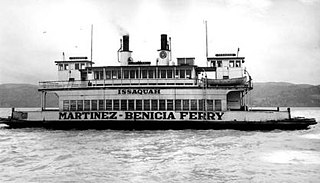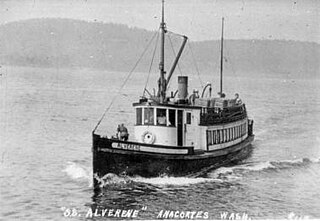Related Research Articles

Manchester is an unincorporated community and census-designated place (CDP) in Kitsap County, Washington, United States. The population was 5,714 at the 2020 census. Manchester is located on the Puget Sound approximately 10 miles from downtown Seattle, and is adjacent to county seat Port Orchard to its east. Today, Manchester labels itself as a village. It is small in size but is home to a Kitsap Regional Library (KRL) branch, a post office, an elementary school, and a beachfront park to serve its residents.

Washington State Ferries (WSF) is a government agency that operates automobile and passenger ferry service in the U.S. state of Washington as part of the Washington State Department of Transportation. It runs ten routes serving 20 terminals located around Puget Sound and in the San Juan Islands, designated as part of the state highway system. The agency maintains the largest fleet of ferries in the United States at 21 vessels. In 2021, the system had a ridership of about 56,800 per weekday as of the third quarter of 2022. As of 2016, it was the largest ferry operator in the United States and the second-largest vehicular ferry system in the world.

State Route 16 (SR 16) is a 27.16-mile-long (43.71 km) state highway in the U.S. state of Washington, connecting Pierce and Kitsap counties. The highway, signed as east–west, begins at an interchange with Interstate 5 (I-5) in Tacoma and travels through the city as a freeway towards the Tacoma Narrows. SR 16 crosses the narrows onto the Kitsap Peninsula on the partially tolled Tacoma Narrows Bridge and continues through Gig Harbor and Port Orchard before the freeway ends in Gorst. The designation ends at an intersection with SR 3 southwest of the beginning of its freeway through Bremerton and Poulsbo. SR 16 is designated as a Strategic Highway Network (STRAHNET) corridor within the National Highway System as the main thoroughfare connecting Tacoma to Naval Base Kitsap and a part of the Highways of Statewide Significance program.

Paratransit is the term used in North America, also known by other names such as community transport (UK) for transportation services that supplement fixed-route mass transit by providing individualized rides without fixed routes or timetables. Paratransit services may vary considerably on the degree of flexibility they provide their customers. At their simplest they may consist of a taxi or small bus that will run along a more or less defined route and then stop to pick up or discharge passengers on request. At the other end of the spectrum—fully demand responsive transport—the most flexible paratransit systems offer on-demand call-up door-to-door service from any origin to any destination in a service area. In addition to public transit agencies, paratransit services may be operated by community groups or not-for-profit organizations, and for-profit private companies or operators.

Kitsap Transit is a public transit agency serving Kitsap County, Washington, part of the Seattle metropolitan area. The system is based in Bremerton and operates bus service on 40 fixed routes, a foot ferry, a vanpool system, worker-driver services, and dial-a-ride services. The Kitsap Fast Ferries are also operated by Kitsap Transit. In 2021, the system had a ridership of 1,736,100, or about 58,000 per weekday as of the third quarter of 2022.

The U.S. state of Washington is home to a number of public and private ferry systems, most notably the state-run Washington State Ferries.

State Route 166 (SR 166) is a 5.13-mile (8.26 km) long state highway serving the city of Port Orchard within Kitsap County in the U.S. state of Washington. The highway begins at an interchange with SR 16 west of Port Orchard and travels along the Sinclair Inlet to Downtown Port Orchard and ends as Mile Hill Drive at Whitter Avenue near the eastern city limits. SR 166 was originally a branch of State Road 14 and later Primary State Highway 14 (PSH 14) before being designated as SR 160 after the 1964 highway renumbering. SR 160 was moved south in 1993 and the old alignment through Port Orchard became SR 166, which was extended in 2010 to the eastern city limits.

State Route 304 (SR 304) is a state highway in Kitsap County, Washington, United States. It connects SR 3, a regional freeway, to the Puget Sound Naval Shipyard and downtown Bremerton. The designation of SR 304 continues onto the Seattle–Bremerton ferry operated by Washington State Ferries to Colman Dock in Downtown Seattle, terminating at SR 519 on Alaskan Way.
The Kitsap County Transportation Company was an important steamboat and ferry company that operated on Puget Sound. The company was founded in 1898 as the Hansen Transportation Company.

Issaquah was a steam ferry built in 1914 that operated on Lake Washington and in San Francisco Bay.

Camano was a steamboat built in 1906 at Coupeville, Washington which operated on Puget Sound from 1906 to 1917. Camano was later known as Tolo. As Tolo the vessel was sunk in 1917 as a result of a collision at sea. Four people died as a result.

Alverene was a gasoline launch built in 1912 which operated on northern Puget Sound and in the San Juan Islands.

The Port Madison-Suquamish-Poulsbo route was a shipping route that originated from Seattle, Washington. The route included stops at Port Madison, Suquamish, and Poulsbo, Washington. As of January 1, 1917, the Kitsap County Transportation Company was operating steamboats on the route. The company also owned a dock at Suquamish and 2,200 feet of waterfront property at Port Madison.
The YWCA-Rolling Bay route was a shipping route that originated from Seattle, Washington. The route included stops on the east side of Bainbridge Island, Washington at the YWCA summer camp and at Rolling Bay.
The Fletcher Bay–Brownsville–Manzanita route was a shipping route that originated from Seattle, Washington. The route included stops at Fletcher Bay, Brownsville, and Manzanita.

Pier 54 is a tourist pier in Seattle, Washington. Previously an active shipping pier and warehouse, Pier 54 was originally known as Pier 3 until it was renumbered during World War II. This pier was also known as Galbraith dock and the Galbraith Bacon dock. Because of the large number of smaller local steamships, generally built of wood, that used the pier up until the 1930s, the pier was also known as the “Mosquito Fleet dock”.

Atlanta was a steamboat built in 1908 at Houghton, Washington which served on Lake Washington and Puget Sound until 1938, when it was converted into a diesel-powered houseboat.

Suquamish, built in 1914, was the first diesel-engined passenger vessel in the United States. Much later Suquamish was converted to a commercial fishing vessel and was registered as a Canadian vessel under the name Terry.

Speeder was a motor launch built in 1908 which served on Puget Sound and in the San Juan Islands. From 1908 to 1922 this vessel was named Bainbridge.

Falcon was a 26 registered ton gasoline-powered launch built in Bellingham, Washington in 1909. She operated in Puget Sound and nearby regions, and also on Lake Washington during the first part of the 1900s. The wreck of this vessel has been discovered in Lake Washington not far from Kirkland and is in good condition under 190 feet (58 m) of water. This vessel should not be confused with the steam tug Falcon built in Tacoma, Washington in 1902.